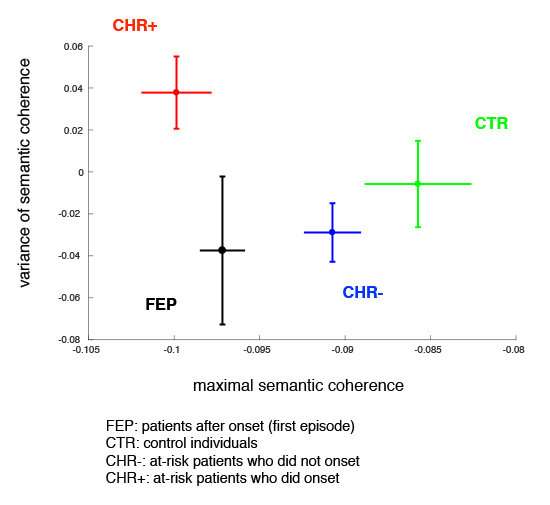Prediction of psychotic onset with AI language analysis

Psychiatrists characterize schizophrenia, a mental condition with devastating effects on those who suffer it, by a set of intuitively understandable concepts including "poverty of speech" and "flight of ideas." These concepts, however, are subjective in the sense that their quantification depends significantly on the particular training and ultimate judgment of individual psychiatrists. The evaluation of a patient is not only subject to this uncertainty, but also to the availability of these highly trained professionals, and to the clinical facilities where evaluation is usually performed.
The IBM Research team for Computational Psychiatry and Neuroimaging has been developing methods intended to mitigate these limitations using Artificial Intelligence (AI) to provide a consistent (i.e. evaluator-independent) neuropsychiatric evaluation from speech samples, which could be delivered remotely. In collaboration with academic researchers, we published results in 2015 showing that it is possible to use AI to model differences in speech patterns between high-risk patients who subsequently developed psychosis and those who did not. Those results were obtained by analyzing baseline interviews in which patients talk about themselves for close to one hour, using the AI method Natural Language Processing (NLP) to quantify the notion of "poverty of speech" as syntactic complexity, and "flight of ideas" as semantic coherence. While successful, this approach had several limitations: only one cohort, from a single location, and using a single evaluation protocol.
In a recent paper, Prediction of psychosis across protocols and risk cohorts using automated language analysis, published in the top-ranked psychiatry journal, World Psychiatry, we took steps toward overcoming these limitations. Studying a different and larger patient cohort, from a different location and a very different evaluation protocol (patients being asked about how they understood a story they read), we built a retrospective model of patient speech patterns that would have predicted with 83 percent accuracy whether a patient subsequently developed psychosis. Significantly, this model also would have predicted with 79 percent accuracy whether patients in the earlier cohort would have developed psychosis. That is, the automated, AI-enabled analysis of the speech patterns of these at-risk patients may have the potential to be highly predictive of the future onset of psychosis in a way that bridges differences in recruitment criteria between institutions, and the specifics of the probing protocol.
We believe this is a significant step towards the goal of developing a tool for mental health practitioners, caregivers and patients themselves with a tool that can expand and multiply the reach of neuropsychiatric assessment outside of the clinic. Stay tuned to hear more about the work we are doing in several other mental health conditions such as depression, Parkinson's and Alzheimer's diseases and chronic pain, among others.
More information: Cheryl M. Corcoran et al. Prediction of psychosis across protocols and risk cohorts using automated language analysis, World Psychiatry (2018). DOI: 10.1002/wps.20491


















